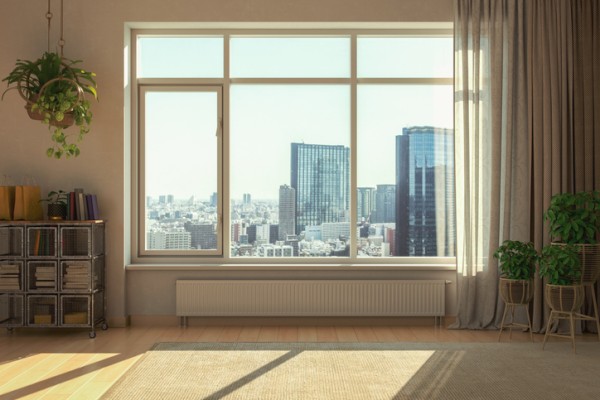
When it comes to designing a home that stays naturally warm in winter and cool in summer, thermal mass plays a big role. But what many homeowners don’t realise is just how much the effectiveness of thermal mass depends on the windows around it.
Get it right, and your home will feel more comfortable year-round with minimal energy use. Get it wrong, and that carefully designed slab or masonry wall might end up working against you.
In this article, we’ll look at how thermal mass works, how windows affect its performance, and how to combine the two for smarter, more sustainable building outcomes.
What is thermal mass?
Thermal mass refers to a material’s ability to absorb, store and release heat. High-mass materials like concrete, brick, rammed earth and stone can soak up heat from the sun during the day and release it slowly as temperatures drop. This process helps regulate indoor temperatures, reducing the need for active heating or cooling.
In Australia’s climate, thermal mass is particularly useful in areas with high day–night temperature swings. But it doesn’t work in isolation—it depends heavily on how heat enters and exits the home.
The role of windows in passive heating
Windows are your home’s gateway to solar heat gain. During winter, the sun’s lower angle means north-facing windows can let in a substantial amount of warmth. If you’ve got thermal mass in the path of this sunlight—like a concrete floor in your living room—it will absorb that heat during the day and slowly release it at night, helping to keep the space warm.
But for this to work effectively, your windows need to be in the right place, sized appropriately and properly glazed. Too little solar access and your thermal mass won’t charge up. Too much, and the space can overheat.
Glazing, orientation and thermal mass
If you’re incorporating thermal mass into your home—especially in floors or internal walls—you’ll need to think carefully about your window orientation and glazing. North-facing windows with good solar access are ideal in most parts of Australia. East- and west-facing windows, on the other hand, can let in harsh, low-angle sun in summer, often at the wrong time of day.
To balance these effects, your windows should:
- Allow sun in during winter, when it’s needed
- Block excessive sun in summer, particularly from the east and west
- Work with eaves or shading devices to manage solar access seasonally
- Use appropriate glazing to control heat transfer and reduce unwanted gains or losses
Double glazing or low-e coatings can help reduce unwanted heat loss at night while still allowing sunlight in during the day. For more on glazing choices, see our article on how to choose interior doors—many of the same performance principles apply to glass doors and large windows.
What happens when thermal mass and windows are out of sync?
If thermal mass is exposed to windows that receive little to no sunlight—say, a concrete floor near shaded or south-facing glazing—it won’t collect enough heat to be useful. Worse, it may end up pulling warmth from the indoor air on cool days or nights, making your space feel colder and increasing the demand on heating systems.
In summer, if windows let in too much sunlight and there’s a lot of thermal mass in the room, the space can retain that heat well into the evening. Without effective cross-ventilation or shading, this can lead to overheating.
Using thermal mass effectively with windows
To make the most of thermal mass, you need to think holistically. That means considering window placement, glazing type, room orientation and ventilation as part of your overall design strategy.
Here are a few key principles:
- North-facing windows + thermal mass = ideal combo
North-facing glazing captures winter sun and works well with concrete or tiled floors to retain heat. - Use eaves or pergolas to control summer sun
Eaves can be designed to block high-angle summer sun while still letting in low-angle winter sun. - Avoid high thermal mass near unshaded west-facing windows
West-facing windows can cause thermal mass to absorb too much heat late in the day, leading to overheating. - Pair thermal mass with ventilation
In summer, good airflow helps release stored heat from mass surfaces. Consider design strategies like vented subfloors and openable windows on opposite sides of a room. - Glazing matters
Don’t let thermal mass go to waste—choose high-performance glass to prevent heat loss at night and reduce summer gains.
Planning for energy efficiency
If you’re renovating or building a home from scratch, get your thermal mass and window strategy right from the design stage. That means working closely with your designer or energy assessor and ensuring that the materials you choose are being used effectively.
For guidance on how these design decisions fit into the broader build process, see our article on the construction process. And if you’re upgrading an existing space, simple retrofits like replacing glazing, adjusting shading or adding insulation can improve how your thermal mass behaves.
In summary
Thermal mass can significantly improve the energy efficiency and comfort of your home, but only when it’s supported by smart window design. Get the orientation, glazing and shading right, and you’ll create a home that naturally moderates its temperature all year round.
Used poorly, however, thermal mass can make spaces colder in winter or hotter in summer, adding to your reliance on heating and cooling systems. The key is coordination: combining materials, window placement and passive solar principles to get the best possible result for your climate and lifestyle.





